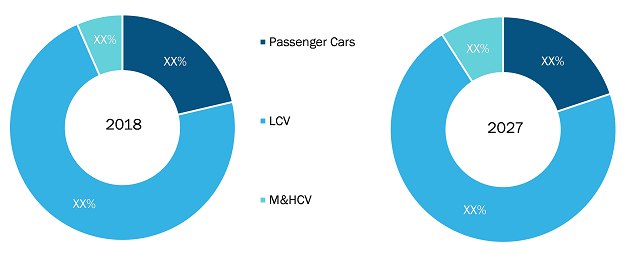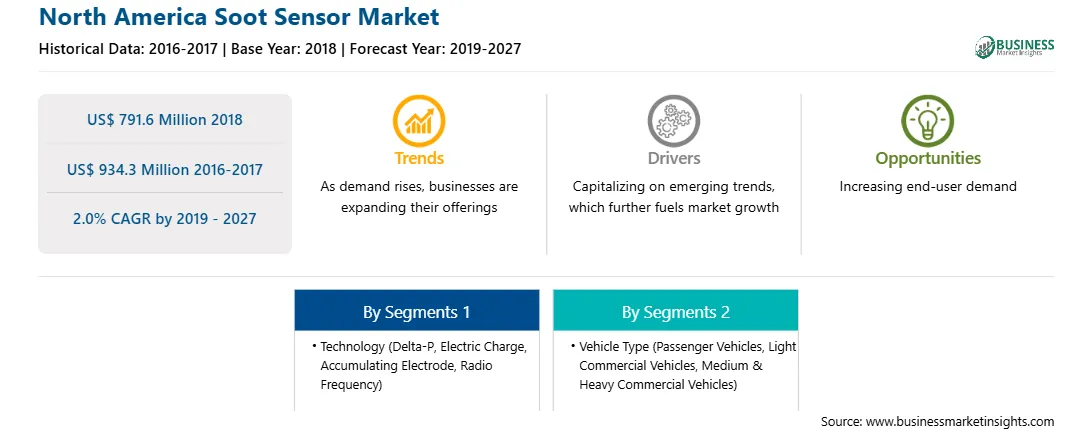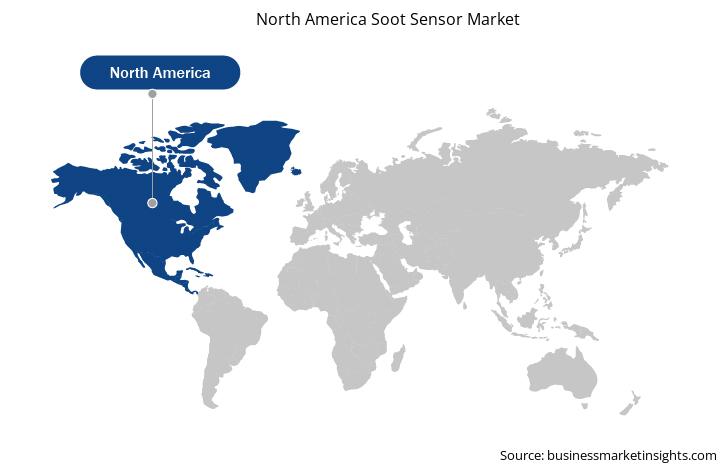Increase in disposable income of individuals is driving the production of automobile and so entire industry. Globally, the production capacity of passenger cars, light, and heavy commercial vehicles are rising. As per the data of OICA, around 95.6 Mn units of vehicles are produced in 2018.
With rising global warming concerns and fuel costs, the automotive industry is frequently improving the combustion performances of their engines. In case of novel diesel engines, they are highly effective, but their nitrous oxide (NOx) and Diesel particulate such as soot emissions exceed by far the legal limits without a proper exhaust gas after treatment system. Diesel engine exhaust gasses contain particulate matter (PM) comprising of aggregated carbon particles which are called as soot. The soot also contains adhered organic compounds like hydrocarbons, and minor amounts of inorganic components like ashes or sulfates. This factor would propel the growth of North America soot sensor market.
The major restraining factor for electric powertrain adoption for HCV’s is the cost parity of these vehicle with its diesel counterparts. As soon the electric trucks have a lower total cost of ownership than their diesel alternatives, fleet owners are expected to switch their preferences. It is estimated that the majority of electric trucks can reach cost parity with their diesel-counterparts in the coming ten to fifteen years, assuming a continuous improvement in battery power density and cost. There would be a marked rise in the North America soot sensor market anticipating the positive impact of technological integrations.
The North America soot sensor market by technology was led by radio frequency technology segment. The North America soot sensor market is bifurcated on the basis of technology into Delta-P, electric charge, accumulating electrode, and radio frequency. Several types of soot sensors, also called as particulate matter are utilized for controlling the emission systems which uses diesel particulate filters (DPF). The soot sensors are basically designed for two types of applications including; for estimating the amount of the soot deposited in a diesel particulate filter to use accurate DPF regeneration strategies.
The North America soot sensor market by vehicle type was led by the medium & heavy commercial vehicles segment. The vehicle type categorizes the North America soot sensor market into passenger vehicles, light commercial vehicles, and medium & heavy commercial vehicles. Use of pickup trucks, mini-vans, SUVs among the masses for myriad applications is rising, which creates a positive impact in the production of diesel-powered engines. Owing to fact, these engines are cost-effective with lower maintenance, and better reliability are gaining high traction in the market.

Strategic insights for the North America Soot Sensor provides data-driven analysis of the industry landscape, including current trends, key players, and regional nuances. These insights offer actionable recommendations, enabling readers to differentiate themselves from competitors by identifying untapped segments or developing unique value propositions. Leveraging data analytics, these insights help industry players anticipate the market shifts, whether investors, manufacturers, or other stakeholders. A future-oriented perspective is essential, helping stakeholders anticipate market shifts and position themselves for long-term success in this dynamic region. Ultimately, effective strategic insights empower readers to make informed decisions that drive profitability and achieve their business objectives within the market.

| Report Attribute | Details |
|---|---|
| Market size in 2018 | US$ 791.6 Million |
| Market Size by 2027 | US$ 934.3 Million |
| Global CAGR (2019 - 2027) | 2.0% |
| Historical Data | 2016-2017 |
| Forecast period | 2019-2027 |
| Segments Covered |
By Technology
|
| Regions and Countries Covered | North America
|
| Market leaders and key company profiles |
The geographic scope of the North America Soot Sensor refers to the specific areas in which a business operates and competes. Understanding local distinctions, such as diverse consumer preferences (e.g., demand for specific plug types or battery backup durations), varying economic conditions, and regulatory environments, is crucial for tailoring strategies to specific markets. Businesses can expand their reach by identifying underserved areas or adapting their offerings to meet local demands. A clear market focus allows for more effective resource allocation, targeted marketing campaigns, and better positioning against local competitors, ultimately driving growth in those targeted areas.

The market players present in the North America soot sensor market are mainly focusing on product enhancements by implementing advanced technologies. By signing partnership, contracts, joint ventures, funding, and inaugurating new offices across the world permit the company to maintain its brand name in North America. Few of the recent developments are listed below:
The List of Companies
The North America Soot Sensor Market is valued at US$ 791.6 Million in 2018, it is projected to reach US$ 934.3 Million by 2027.
As per our report North America Soot Sensor Market, the market size is valued at US$ 791.6 Million in 2018, projecting it to reach US$ 934.3 Million by 2027. This translates to a CAGR of approximately 2.0% during the forecast period.
The North America Soot Sensor Market report typically cover these key segments-
The historic period, base year, and forecast period can vary slightly depending on the specific market research report. However, for the North America Soot Sensor Market report:
The North America Soot Sensor Market is populated by several key players, each contributing to its growth and innovation. Some of the major players include:
The North America Soot Sensor Market report is valuable for diverse stakeholders, including:
Essentially, anyone involved in or considering involvement in the North America Soot Sensor Market value chain can benefit from the information contained in a comprehensive market report.